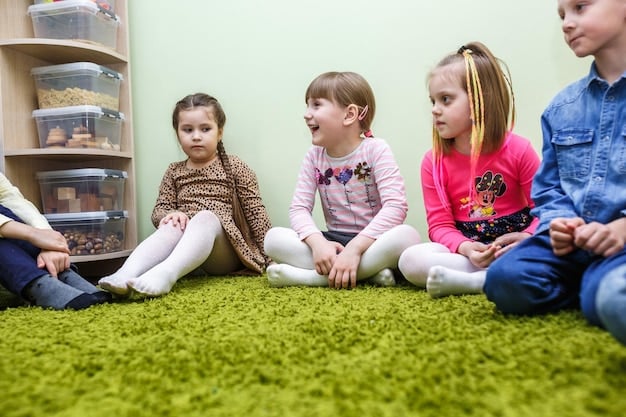Understanding Your Child’s Learning Style: A Guide for Parents

Understanding your child’s learning style—visual, auditory, or kinesthetic—is crucial for tailoring educational approaches that resonate with their unique strengths, enhancing comprehension and fostering a lifelong love for learning.
Every child learns differently. Understanding your child’s learning style – visual, auditory, or kinesthetic – can unlock their full potential and make learning a more enjoyable and effective experience for them.
Identifying Different Learning Styles
Recognizing how your child learns best is the first step in supporting their educational journey. There are primarily three learning styles: visual, auditory, and kinesthetic. Each style involves a different way of processing information.
Visual Learners
Visual learners grasp concepts more easily when they see information presented in a visual format. This includes diagrams, charts, pictures, and videos. They often benefit from written instructions and enjoy reading.
Auditory Learners
Auditory learners learn best by listening. They thrive in environments where they can hear lectures, participate in discussions, and listen to recordings. They often remember things they hear more easily than things they see.
Kinesthetic Learners
Kinesthetic learners, also known as tactile learners, learn through physical activity and hands-on experiences. They prefer to touch, move, and interact with their environment. They may find it difficult to sit still for long periods.
Understanding these different learning styles can help you better tailor your approach to teaching and supporting your child.
Characteristics of Visual Learners
Visual learners have distinct traits that set them apart. Understanding these characteristics can help parents and educators identify and cater to their specific needs.
Preference for Visual Aids
Visual learners typically prefer visual aids such as graphs, charts, and diagrams. They often find it easier to understand and remember information when it’s presented in a visual format.
Strong Sense of Color and Spatial Awareness
These learners often have a strong sense of color and spatial awareness. They may be drawn to visual arts and have a natural ability to visualize and manipulate objects in their mind.
Difficulty with Auditory Instructions
Visual learners may struggle with purely auditory instructions and explanations. They often need to see something demonstrated or written down to fully understand it.
- Prefer to take notes and review them later.
- Enjoy using highlighters and color-coded systems.
- Learn best when they can see a demonstration.
- Tend to be very organized and detail-oriented.
By recognizing these characteristics, you can provide visual learners with the tools and resources they need to succeed academically.

Characteristics of Auditory Learners
Auditory learners possess distinct traits that make listening and verbal interaction their preferred method of learning. Recognizing these traits can help educators and parents support them effectively.
Preference for Listening
Auditory learners often prefer listening to lectures and participating in discussions. They tend to retain information better when it is spoken rather than written.
Strong Verbal Skills
These learners typically have strong verbal skills and enjoy expressing themselves through speaking and writing. They are often good at explaining concepts to others.
Distraction by Noise
Auditory learners can be easily distracted by noise. They often need a quiet environment to concentrate and learn effectively.
Identifying whether your child is an auditory learner can significantly impact your approach to their education.
Characteristics of Kinesthetic Learners
Kinesthetic learners, also known as tactile learners, thrive on physical activity and hands-on experiences. Understanding their unique traits is key to creating an engaging learning environment.
Preference for Movement
Kinesthetic learners often prefer movement and physical activity while learning. They may fidget or have difficulty sitting still for long periods.
Hands-On Learning
These learners learn best by doing. They enjoy activities such as building models, conducting experiments, and role-playing.
Difficulty with Abstract Concepts
Kinesthetic learners may struggle with abstract concepts that are not connected to real-world experiences. They need to see and feel how things work to fully understand them.
- Enjoy active breaks and activities.
- Benefit from using manipulatives and models.
- Remember information better when physically involved.
- Tend to be creative and inventive.
Understanding these characteristics can help you provide kinesthetic learners with the tools and opportunities they need to succeed academically and beyond.
Strategies for Visual Learners
To effectively support visual learners, it’s important to incorporate visual aids and strategies into their learning environment. These techniques can help them grasp concepts and improve retention.
Use Visual Aids
Incorporate visual aids such as charts, graphs, diagrams, and pictures into lessons. These tools can help visual learners see and understand complex information more easily.
Encourage Note-Taking
Encourage visual learners to take detailed notes during lectures and readings. Writing things down can help them process and remember information.
Color-Coding
Use color-coding systems to organize notes and study materials. This can help visual learners quickly identify key concepts and relationships.
There some more strategies below that can help visual learners and the important thing is making them enjoyable for the learner.
Strategies for Auditory Learners
Auditory learners benefit from strategies that emphasize sound and verbal interaction. Incorporating these techniques into their learning can enhance their understanding and retention.
Encourage Discussion
Encourage auditory learners to participate in discussions and ask questions. Verbalizing their thoughts can help them clarify concepts and remember information.
Use Recordings
Use recordings of lectures and readings so that auditory learners can listen and review the material. This allows them to reinforce their understanding through repetition.
Create a Quiet Study Environment
Provide a quiet study environment free from distractions. Auditory learners often need a calm space to concentrate and learn effectively.
Auditory learners tend to learn easier when the surrounding are quiet, enabling them to hear clearly what is needed.

Strategies for Kinesthetic Learners
Kinesthetic learners thrive with hands-on experiences and physical activity. By incorporating these strategies into their learning, you can help them stay engaged and retain information more effectively.
Hands-On Activities
Integrate hands-on activities such as building models, conducting experiments, and role-playing into lessons. These activities can help kinesthetic learners connect with the material in a meaningful way.
Take Frequent Breaks
Allow kinesthetic learners to take frequent breaks and move around. This can help them release energy and stay focused during learning.
Use Manipulatives
Use manipulatives such as blocks, puzzles, and clay to illustrate concepts. These tools can help kinesthetic learners visualize and understand abstract ideas.
Making the activities enjoyable is definitely a great way for kinesthetic learners to learn.
| Key Point | Brief Description |
|---|---|
| 👁️ Visual Learners | Learn best through visual aids like charts and diagrams. |
| 👂 Auditory Learners | Prefer listening, discussions, and verbal instructions. |
| 🖐️ Kinesthetic Learners | Learn through physical activity and hands-on experiences. |
| 🧩 Tailored Strategies | Use specific methods for each style to enhance learning. |
Frequently Asked Questions
▼
Observe how your child approaches new tasks. Do they prefer looking at diagrams, listening to instructions, or trying things out themselves? Pay attention to what methods seem to resonate most with them.
▼
Yes, many children have a combination of learning styles. While they may have a dominant preference, they can also benefit from strategies that cater to other styles.
▼
Yes, a child’s learning style can evolve as they grow and develop. Regularly reassessing their preferences can help you adapt your teaching methods to meet their changing needs.
▼
Supplement their learning at home with activities and resources that align with their learning style. Communicate with their teachers to explore ways to incorporate these strategies into the classroom.
▼
Yes, numerous websites and apps offer resources and activities tailored to different learning styles. Research and experiment with different options to find what works best for your child.
Conclusion
Understanding your child’s learning style is a powerful tool that enhances their educational experience and fosters a lifelong love for learning. By identifying whether they are visual, auditory, or kinesthetic learners, you can tailor your teaching methods to resonate with their unique strengths. This personalized approach not only improves their academic performance but also builds their confidence and enthusiasm for learning.





